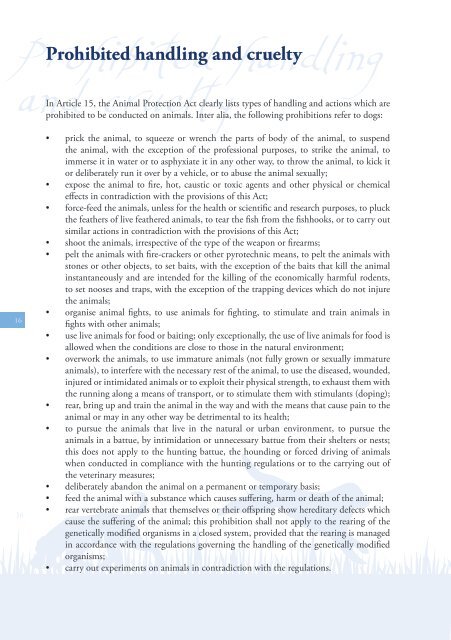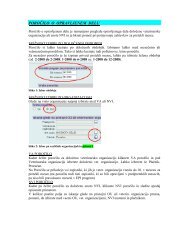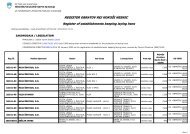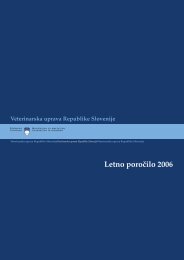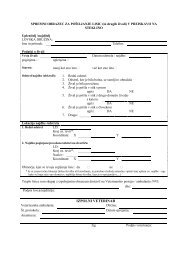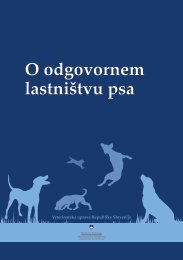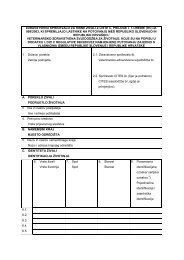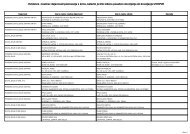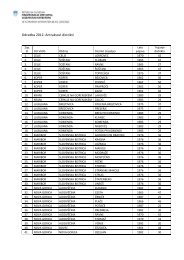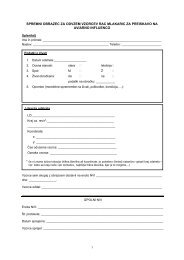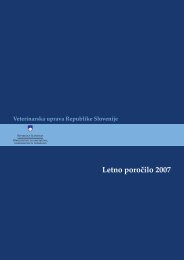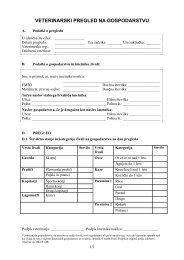Responsible Dog Ownership
Responsible Dog Ownership
Responsible Dog Ownership
Create successful ePaper yourself
Turn your PDF publications into a flip-book with our unique Google optimized e-Paper software.
O odgovornem lastništvu psa<br />
Prohibited handling and<br />
handling<br />
cruelty<br />
and cruelty<br />
In Article 15, the Animal Protection Act clearly lists types of handling and actions which are<br />
prohibited to be conducted on animals. Inter alia, the following prohibitions refer to dogs:<br />
16<br />
16<br />
• prick the animal, to squeeze or wrench the parts of body of the animal, to suspend<br />
the animal, with the exception of the professional purposes, to strike the animal, to<br />
immerse it in water or to asphyxiate it in any other way, to throw the animal, to kick it<br />
or deliberately run it over by a vehicle, or to abuse the animal sexually;<br />
• expose the animal to fire, hot, caustic or toxic agents and other physical or chemical<br />
effects in contradiction with the provisions of this Act;<br />
• force-feed the animals, unless for the health or scientific and research purposes, to pluck<br />
the feathers of live feathered animals, to tear the fish from the fishhooks, or to carry out<br />
similar actions in contradiction with the provisions of this Act;<br />
• shoot the animals, irrespective of the type of the weapon or firearms;<br />
• pelt the animals with fire-crackers or other pyrotechnic means, to pelt the animals with<br />
stones or other objects, to set baits, with the exception of the baits that kill the animal<br />
instantaneously and are intended for the killing of the economically harmful rodents,<br />
to set nooses and traps, with the exception of the trapping devices which do not injure<br />
the animals;<br />
• organise animal fights, to use animals for fighting, to stimulate and train animals in<br />
fights with other animals;<br />
• use live animals for food or baiting; only exceptionally, the use of live animals for food is<br />
allowed when the conditions are close to those in the natural environment;<br />
• overwork the animals, to use immature animals (not fully grown or sexually immature<br />
animals), to interfere with the necessary rest of the animal, to use the diseased, wounded,<br />
injured or intimidated animals or to exploit their physical strength, to exhaust them with<br />
the running along a means of transport, or to stimulate them with stimulants (doping);<br />
• rear, bring up and train the animal in the way and with the means that cause pain to the<br />
animal or may in any other way be detrimental to its health;<br />
• to pursue the animals that live in the natural or urban environment, to pursue the<br />
animals in a battue, by intimidation or unnecessary battue from their shelters or nests;<br />
this does not apply to the hunting battue, the hounding or forced driving of animals<br />
when conducted in compliance with the hunting regulations or to the carrying out of<br />
the veterinary measures;<br />
• deliberately abandon the animal on a permanent or temporary basis;<br />
• feed the animal with a substance which causes suffering, harm or death of the animal;<br />
• rear vertebrate animals that themselves or their offspring show hereditary defects which<br />
cause the suffering of the animal; this prohibition shall not apply to the rearing of the<br />
genetically modified organisms in a closed system, provided that the rearing is managed<br />
in accordance with the regulations governing the handling of the genetically modified<br />
organisms;<br />
• carry out experiments on animals in contradiction with the regulations.


